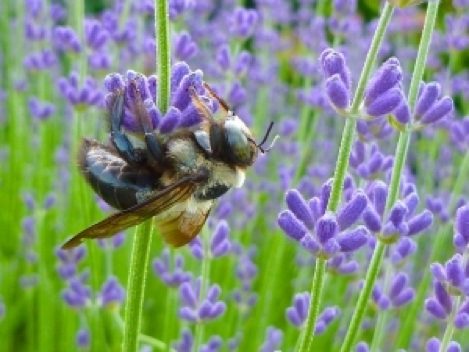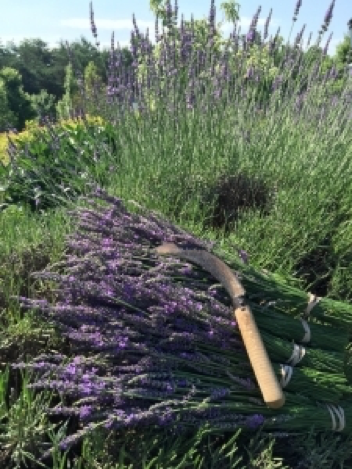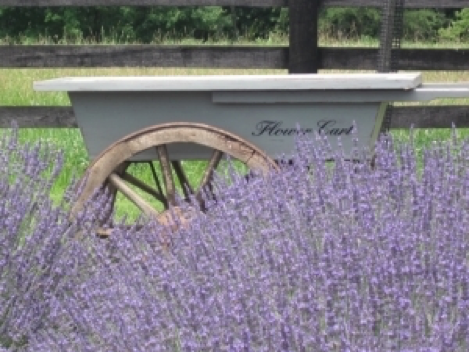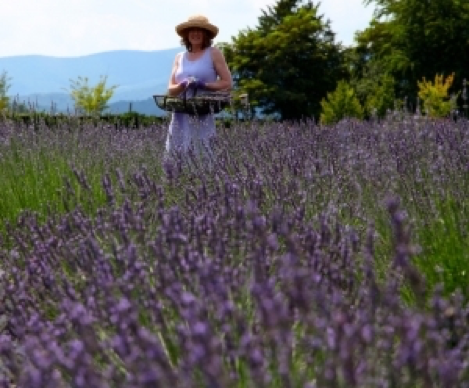Growing Lavender in Central Virginia
By Eileen DeCamp, Piedmont MG • May 28, 2020
This article was originally printed in The Garden Shed, a community newsletter by Piedmont Master Gardeners, and is posted here with permission of the author. Much of this information also applies to our area in Hampton Roads.
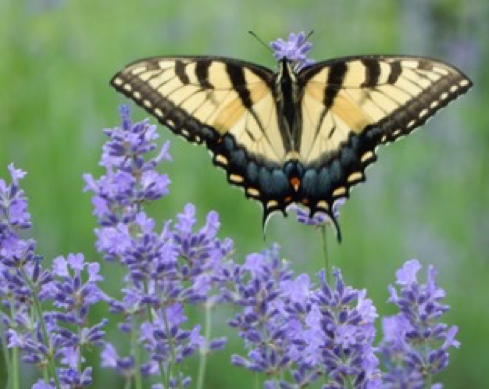
The Garden Shed editor’s note:
Our guest author Eileen DeCamp fell in love with lavender on a trip to Provence and has been growing it in Albemarle County since 2008. She took a course on growing lavender, and as her expertise grew, she became involved with other lavender growers, and joined the newly-formed United States Lavender Association in 2013.
Lavender is a beautiful addition to any garden, and there are over 450 lavender varieties and cultivars for the gardener to choose from! Lavender belongs to the Lamiaceae, or mint family, and comes in many sizes, foliage colors and flower colors. All lavenders are great for pollinators and are just a beautiful addition to your garden.
The two most popular types are Lavandula augustifolia
— commonly called English lavender or just plain “lavender”
– and Lavandula x Intermedia, commonly known as “lavandin.”
The lavandins are a hybrid cross of the English species and the spike or Portuguese lavender (L. latifolia). Although the lavenders and lavandins are similar, the lavenders have a sweeter aroma and the lavandins are a bit more camphorous. It is just a scent preference. You have probably seen a third type — Lavandula stoechas — with its cylindrical flower heads topped with leaf-like bracts that look like butterfly wings. You will have to prune this type all summer to get continual flowering, and it is not hardy in our zone 7.
Lavenders are native to southern Europe, where the soil is rocky and lean. Those of you who have been on vacation in the Mediterranean know that it is dry with lots of sunshine. Here in Central Virginia — with clay soil, wet springs and summers and lots of humidity — growing lavender can be a challenge, but it can be done with a little planning and preparation of your selected site.
How to Grow Lavender in central Virginia
If you are thinking of planting lavender in your garden, step one is to test your soil. Lavender likes a neutral pH of 6.5 to 7.5, so you may need to add lime to our acidic local soil. When you submit your soil for testing, be sure to indicate that lavender is what you intend to plant. Then the soil test results from Virginia Tech’s Soil Test Lab
will tell you exactly how much lime to add. If you are planting lavender with other plants, try to choose plants that have the same requirements.
Well-drained soil is key to success with lavender. Lavender does NOT like wet feet, and without proper drainage, it will develop root rot. If you have clay soil, you will need to amend with organic matter, preferably compost. Remember, lavenders grow well in rocky, sandy, dry soils, so your clay may benefit from the addition of small stones or gravel. You can also plant your lavender on mounds or on a slope, which will help with drainage. If you are planting a row of lavender, make sure you have enough room around each plant for air circulation, which is especially important in our area due to the humidity. You also want a site that receives 6-8 hours of full sun. Lavender doesn’t need much fertilizer. Once lavender is established, you could use a low-nitrogen fertilizer to establish stronger roots. Do not mulch your lavender with regular wood mulch because that will hold in moisture, which can cause root rot. You can mulch with pea gravel or white rock, which will reflect the sun under the plant to dry out any water from heavy rains.
After the lavender has bloomed, which is usually anywhere from the end of May to mid-July, you will want to prune it to keep it from becoming woody or leggy. This also helps protect the lavender in the winter from breaking open from heavy snowfall. I usually prune my lavender in early September so it has time to recover before the cold sets in. I usually cut it back by 1/3.
Which varieties to plant?
I recommend a few varieties that have been very successful in my gardens. The first is the cultivar Grosso (Lavenula x Intermedia ‘Grosso’), a lavandin which becomes quite large, 32-36 inches in height, with stems of 20-24 inches. Grosso has a gorgeous dark purple color. If you have the room in your garden, this is a great one to try.
The cultivar ‘Hidcote’ (Lavandula angustifolia) is a good one to try in a smaller space. Its stems are shorter — about 6-8 inches, the plant height is 12-20 inches, and the flowers are a lovely dark blue color. This is an excellent lavender to try in recipes or lavender lemonade.
If you would like to try a pink lavender, then ‘Melissa’ is an excellent choice. It is also used in culinary dishes, and its stem length is 8-10 inches and the plant height is 30 inches.
If you have a really small area, then try ‘Wee One’ (Lavandula angustifolia ‘Wee One’), a dwarf variety which only gets 10 inches tall and has short blue flower spikes.
I must also mention a new cultivar that is getting rave reviews — Lavandula x Intermedia ‘Phenomenal’ — a lavandin which reportedly stands up to our humidity and weather conditions better than others.
If you would like to learn more about lavender, I would recommend The Lavender Lover’s Handbook by Sarah Berringer Bader. This excellent resource features 100 varieties with information on growing, harvesting, cooking, and crafting. The photos are lovely and accompanied by helpful information on each variety.
I know from experience that it can be challenging to grow a Mediterranean plant like lavender in Central Virginia, but with a little work and care, you can do it!
SOURCES:
The Lavender Lover’s Handbook: The 100 Most Beautiful and Fragrant Varieties for Growing, Crafting, and Cooking (Bader, 2012).
Lavandula x Intermedia ‘Grosso,’ http://www.missouribotanicalgarden.org/PlantFinder/PlantFinderDetails.aspx?kempercode=a393
Lavandula angustifolia ‘Hidcote’ https://www.missouribotanicalgarden.org/PlantFinder/PlantFinderDetails.aspx?kempercode=q830
Lavandula x intermedia ‘Phenomenal’ https://extension.psu.edu/programs/master-gardener/counties/allegheny/additional-resources/plant-sale/lavandula-x-intermedia-phenomenal-phenomenal
“Lavender: History, Taxonomy, and Production,” North Carolina State Extension, https://newcropsorganics.ces.ncsu.edu/herb/lavender

